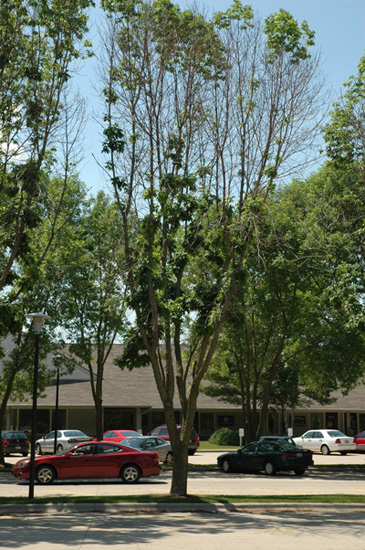Issue 12, July 17, 2009
Ash Yellows
In a recent conversation with a friend I realized that some people think that if they see a declining ash in Illinois, then it must be caused by Emerald ash borer. This is far from accurate. We have been seeing problems with ash trees declining for at least 30 years in Illinois without the help of Emerald ash borer. One disease that may look much like a tree infested with Emerald ash borers (or other borers) is a disease called ash yellows.
Ash yellows disease primarily affects white and green ash in the north central and northeastern parts of the United States. It is definitely a problem in Illinois, but one that is difficult to quantify, because its presence is difficult to confirm. The disease looks like other problems and testing is expensive.
Ash yellows disease is caused by a phytoplasma (formerly called mycoplasma-like-organism or MLO). These pathogens are somewhat like virus particles, cannot be cultured in a lab, and are limited to the phloem tissue of the tree. Phytoplasmas are spread by phloem feeding insects.
This disease is characterized by loss of plant vigor over a period of 2 to 10 years before the tree dies. Symptoms include short internodes (poor growth) and tufting of foliage at branch ends. Leaves become pale green to chlorotic (yellowed) and might develop fall colors prematurely. The tree may or may not defoliate, but the canopy generally appears sparse. Cankers form on both branches and the trunk, causing twigs and branches to die back. Witches' broom sprouts of growth might appear on some branches, but are more common on the trunk near the ground as seen in the image from the US Forest Service. Cracks in the trunk may appear in this area as well. It is rare for an ash tree to recover from ash yellows.

A great percentage of the ash trees in Illinois landscapes are green ash. They do not show ash yellows symptoms as clearly as white ash. It is very likely that this yellows disease is more common than we realize because the typical witches' brooms and yellowing are not always seen with green ash, even when the disease is present. Instead we see only the cankers and stem dieback, conditions which suggest ash decline (second image) or Verticillium wilt or even Emerald ash borer.

The ash yellows phytoplasma cannot be cultured in a laboratory on artificial media like fungal or bacterial pathogens. One method of proving the presence of a phytoplasma is to find a lab that offers PCR (polymerase chain reaction) testing for phytoplasmas. AGDIA, Inc, a private company in Indiana, has such a service. They offer a nested PCR test for phytoplasmas in general. The cost is currently about $190.00 for the first sample and much less for each additional sample. If you want to know the specific phytoplasma you can add about $50.00 more for a gene sequence to obtain the specific phytoplasma. You will want to contact your testing service of choice before sending a sample because the type of sample needed (leaves, roots, bark, etc.) depends on the time of year. It is obvious why this disease has not been confirmed frequently in Illinois.--Nancy Pataky
Author:
Nancy Pataky